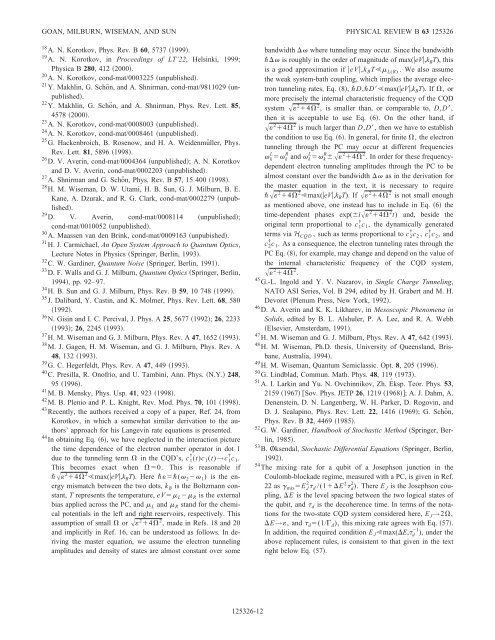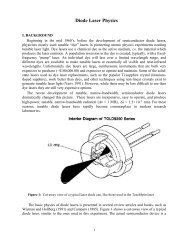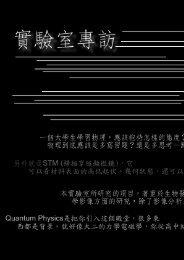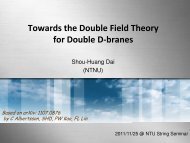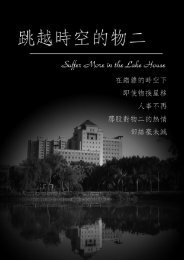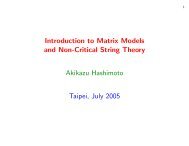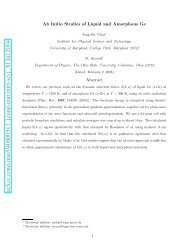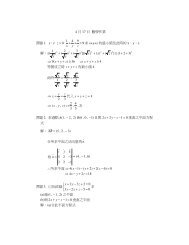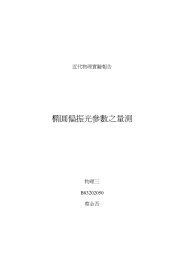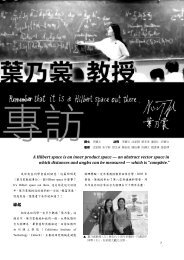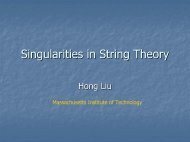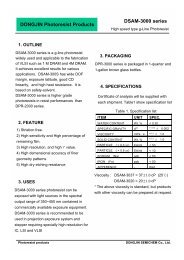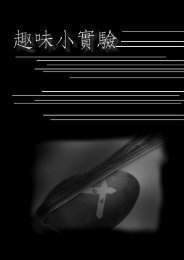Continuous quantum measurement of two coupled quantum dots ...
Continuous quantum measurement of two coupled quantum dots ...
Continuous quantum measurement of two coupled quantum dots ...
You also want an ePaper? Increase the reach of your titles
YUMPU automatically turns print PDFs into web optimized ePapers that Google loves.
GOAN, MILBURN, WISEMAN, AND SUN PHYSICAL REVIEW B 63 12532618 A. N. Korotkov, Phys. Rev. B 60, 5737 1999.19 A. N. Korotkov, in Proceedings <strong>of</strong> LT’22, Helsinki, 1999;Physica B 280, 412 2000.20 A. N. Korotkov, cond-mat/0003225 unpublished.21 Y. Makhlin, G. Schön, and A. Shnirman, cond-mat/9811029 unpublished.22 Y. Makhlin, G. Schön, and A. Shnirman, Phys. Rev. Lett. 85,4578 2000.23 A. N. Korotkov, cond-mat/0008003 unpublished.24 A. N. Korotkov, cond-mat/0008461 unpublished.25 G. Hackenbroich, B. Rosenow, and H. A. Weidenmüller, Phys.Rev. Lett. 81, 5896 1998.26 D. V. Averin, cond-mat/0004364 unpublished; A. N. Korotkovand D. V. Averin, cond-mat/0002203 unpublished.27 A. Shnirman and G. Schön, Phys. Rev. B 57, 154001998.28 H. M. Wiseman, D. W. Utami, H. B. Sun, G. J. Milburn, B. E.Kane, A. Dzurak, and R. G. Clark, cond-mat/0002279 unpublished.29 D. V. Averin, cond-mat/0008114 unpublished;cond-mat/0010052 unpublished.30 A. Maassen van den Brink, cond-mat/0009163 unpubished.31 H. J. Carmichael, An Open System Approach to Quantum Optics,Lecture Notes in Physics Springer, Berlin, 1993.32 C. W. Gardiner, Quantum Noise Springer, Berlin, 1991.33 D. F. Walls and G. J. Milburn, Quantum Optics Springer, Berlin,1994, pp. 92–97.34 H. B. Sun and G. J. Milburn, Phys. Rev. B 59, 107481999.35 J. Dalibard, Y. Castin, and K. Molmer, Phys. Rev. Lett. 68, 5801992.36 N. Gisin and I. C. Percival, J. Phys. A 25, 5677 1992; 26, 22331993; 26, 2245 1993.37 H. M. Wiseman and G. J. Milburn, Phys. Rev. A 47, 1652 1993.38 M. J. Gagen, H. M. Wiseman, and G. J. Milburn, Phys. Rev. A48, 132 1993.39 G. C. Hegerfeldt, Phys. Rev. A 47, 449 1993.40 C. Presilla, R. On<strong>of</strong>rio, and U. Tambini, Ann. Phys. N.Y. 248,95 1996.41 M. B. Mensky, Phys. Usp. 41, 923 1998.42 M. B. Plenio and P. L. Knight, Rev. Mod. Phys. 70, 101 1998.43 Recently, the authors received a copy <strong>of</strong> a paper, Ref. 24, fromKorotkov, in which a somewhat similar derivation to the authors’approach for his Langevin rate equations is presented.44 In obtaining Eq. 6, we have neglected in the interaction picturethe time dependence <strong>of</strong> the electron number operator in dot 1due to the tunneling term in the CQD’s, c † 1 (t)c 1 (t)→c † 1 c 1 .This becomes exact when 0. This is reasonable if 2 4 2 max(eV,k B T). Here ( 2 1 ) is the energymismatch between the <strong>two</strong> <strong>dots</strong>, k B is the Boltzmann constant,T represents the temperature, eV L R is the externalbias applied across the PC, and L and R stand for the chemicalpotentials in the left and right reservoirs, respectively. Thisassumption <strong>of</strong> small or 2 4 2 , made in Refs. 18 and 20and implicitly in Ref. 16, can be understood as follows. In derivingthe master equation, we assume the electron tunnelingamplitudes and density <strong>of</strong> states are almost constant over somebandwidth where tunneling may occur. Since the bandwidth is roughly in the order <strong>of</strong> magnitude <strong>of</strong> max(eV,k B T), thisis a good approximation if eV,k B T L(R) . We also assumethe weak system-bath coupling, which implies the average electrontunneling rates, Eq. 8, D,Dmax(eV,k B T). If , ormore precisely the internal characteristic frequency <strong>of</strong> the CQDsystem 2 4 2 , is smaller than, or comparable to, D,D,then it is acceptable to use Eq. 6. On the other hand, if 2 4 2 is much larger than D,D, then we have to establishthe condition to use Eq. 6. In general, for finite , the electrontunneling through the PC may occur at different frequencies L k R k and L k R k 2 4 2 . In order for these frequencydependentelectron tunneling amplitudes through the PC to bealmost constant over the bandwidth as in the derivation forthe master equation in the text, it is necessary to require 2 4 2 max(eV,k B T). If 2 4 2 is not small enoughas mentioned above, one instead has to include in Eq. 6 thetime-dependent phases exp(i 2 4 2 t) and, beside theoriginal term proportional to c † 1 c 1 , the dynamically generatedterms via H CQD , such as terms proportional to c † 2 c 2 , c † 1 c 2 , andc † 2 c 1 . As a consequence, the electron tunneling rates through thePC Eq. 8, for example, may change and depend on the value <strong>of</strong>the internal characteristic frequency <strong>of</strong> the CQD system, 2 4 2 .45 G.-L. Ingold and Y. V. Nazarov, in Single Charge Tunneling,NATO ASI Series, Vol. B 294, edited by H. Grabert and M. H.Devoret Plenum Press, New York, 1992.46 D. A. Averin and K. K. Likharev, in Mesoscopic Phenomena inSolids, edited by B. L. Alshuler, P. A. Lee, and R. A. WebbElsevier, Amsterdam, 1991.47 H. M. Wiseman and G. J. Milburn, Phys. Rev. A 47, 642 1993.48 H. M. Wiseman, Ph.D. thesis, University <strong>of</strong> Queensland, Brisbane,Australia, 1994.49 H. M. Wiseman, Quantum Semiclassic. Opt. 8, 205 1996.50 G. Lindblad, Commun. Math. Phys. 48, 119 1973.51 A. I. Larkin and Yu. N. Ovchinnikov, Zh. Éksp. Teor. Phys. 53,2159 1967 Sov. Phys. JETP 26, 1219 1968; A. J. Dahm, A.Denenstein, D. N. Langenberg, W. H. Parker, D. Rogovin, andD. J. Scalapino, Phys. Rev. Lett. 22, 1416 1969; G. Schön,Phys. Rev. B 32, 4469 1985.52 G. W. Gardiner, Handbook <strong>of</strong> Stochastic Method Springer, Berlin,1985.53 B. O” ksendal, Stochastic Differential Equations Springer, Berlin,1992.54 The mixing rate for a qubit <strong>of</strong> a Josephson junction in theCoulomb-blockade regime, measured with a PC, is given in Ref.22 as mix E 2 J d /(1E 2 2 d ). There E J is the Josephson coupling,E is the level spacing between the <strong>two</strong> logical states <strong>of</strong>the qubit, and d is the decoherence time. In terms <strong>of</strong> the notationsfor the <strong>two</strong>-state CQD system considered here, E J →2,E→, and d (1/ d ), this mixing rate agrees with Eq. 57.In addition, the required condition E J max(E, 1 d ), under theabove replacement rules, is consistent to that given in the textright below Eq. 57.125326-12


